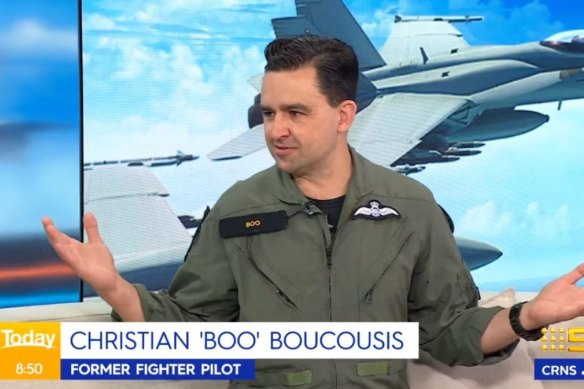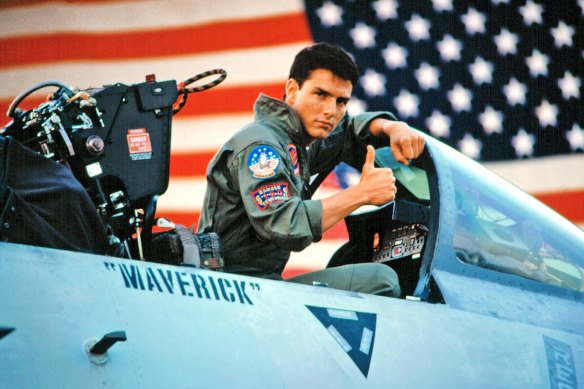By Emma Goldberg
“Your company is about to go on a rescue,” declared Christian Boucousis, who goes by the name Boo at work. “One of your company members went out to do reconnaissance and was shot down. Now you’re going to rescue your teammate and bring them home.”
Boucousis, a former Royal Australian Air Force pilot, is CEO of an organisation called Afterburner, which promises to teach “the same precision and accuracy as elite military aviators” to corporate clients. His firm has worked with Nike, Pepsi, Bank of America and many other brands. These businesses aren’t struggling to save teammates shot down by enemy squadrons. Their problems? Market competition, shareholder pressures, employee turnover.

Former RAAF pilot Christian Boucousis now runs a leadership training company.Credit: Nine
Some corporate executives find it thrilling, though, to spend a few hours feeling less like C-suite dwellers and more like Tom Cruise. Even for a significant cost: Afterburner’s “Top Gun Experience” training starts at $US10,000 ($15,000) for a small team and can climb to $US100,000 for a larger one.
“If you lose sight of the airplane you’re fighting against, you lose the fight,” Boucousis said. “We use that as a metaphor — if you lose sight of your business objectives, you’re not going to achieve them.”
There are a lot metaphors at work in this growing field: The office as battlefield. Landing the plane in a tough quarter. Rallying the troops for a product launch.
Work is war — or it can feel that way to certain CEOs. To meet the moment, it’s the era of “Top Gun”-style leadership training.
Many business leaders responded to the past few years of uncertainty — workforce churn, return-to-office struggles, economic flux — by bringing softer, more emotional conversations into boardrooms. Some encouraged open discussions of employee mental health in the office. One CEO, drawing backlash, even posted a selfie on LinkedIn showing tears streaming down his face after he laid off two employees.
Others went in the opposite direction, embracing a new style of corporate machismo. Elon Musk challenged Mark Zuckerberg to a cage match; Zuckerberg, who has been training in Brazilian jujitsu for 18 months, texted the president of the UFC to see if his rival had been serious about the proposition.
Corporate offices have long been filled with signs of aggression: shouting, cursing, traders pacing the floors with lacrosse sticks. Many of those came under scrutiny amid a push for more diversity and inclusion in the corporate world. But during times of economic pressure, the chest-thumping can sometimes come back in full force, some management experts say.
“Leaders are trying to regain a sense of control they feel they’ve lost over the last few years,” said Cali Williams Yost, a workplace strategist. “They’re searching to reassert control and power in a way that feels familiar.”
Companies have long valued military experience in hiring. Hollywood has for decades valorised military leaders as the ultimate examples of strength. But now, corporate executives are actually playacting as military members. Hundreds of companies are turning to unorthodox programs that use fighter-pilot simulations, military principles and even NASCAR pit-stop techniques to train business executives on responding to uncertainty and flux.

Corporate machismo: Mark Zuckerberg and Elon Musk are talking about taking each other on in a cage fight.Credit: AP
Women can and do participate in these trainings, but many of the companies offering them are run by men — a source of concern for some management experts, who say workers are looking for more empathic leadership styles, not hyper-aggressive ones. The share of Fortune 500 companies run by women just crept over the 10 per cent mark this year.
“I don’t think it aligns with what most people say they’re looking for in a leader, which is human-centric, empathetic, collaborative,” Yost said.
Military veterans, such as Jocko Willink, a former Navy SEAL, are unsurprised that a period of workplace chaos is pushing companies to rethink management, sometimes in extreme ways.
“The pandemic revealed that we need better leadership,” Willink said. “When people aren’t coming in to work and you no longer see them every day, you have to use better decentralised command. That’s a classic law of combat leadership.”
Whether Navy SEALs wisdom translates to a product release, though, isn’t clear. “The question is — is it meant to be fun? Is it meant to be photographed? Or is it meant to be impactful?,” Melissa Nightingale, co-founder of management training firm Raw Signal Group, said of professional development. “About 75 per cent of professional development efforts fall on the floor.”
Still, the management machismo keeps spreading, as companies clamour to train their employees in ways that don’t involve a Zoom screen. Like, for example, in a race car pit.
In Raleigh, North Carolina, a financial technology company called Constellation Digital Partners brought its employees together — some meeting in person for the first time — to simulate a NASCAR pit stop. The training was facilitated by a company called Over the Wall, which was started by a former NASCAR pit crew coach, Andy Papathanassiou; rates start at $US10,000 and vary depending on the size of the group and how much time it spends training.

Military experience has long been valued by companies.
Constellation’s roughly 30 employees gathered in their office parking lot around a green race car. The employees took off lug nuts with an air wrench, hoisted off the car’s 23-kilogram tyre, swapped in a new tyre and got the lug nuts back on. They were dripping in sweat, sunscreen and grease, looking like the harried pit stop crew members of Cruise’s movie Days of Thunder.
“It sounds silly for me to say, but the hardest part is actually getting the tyre on,” said Kris Kovacs, the company’s CEO. “What that teaches you is you’ve got to preplan. Hard things, if you practice at them and preplan, become easier and easier.”
In the months after the training, Kovacs said he saw his staff become more communicative. They understood how to share their weak points with one another.
“You can do all the ‘Kumbaya’ trust-fall stuff,” he said. “Or you can get dirty with your team throwing tyres onto NASCARs.”
This article originally appeared in The New York Times.
The Business Briefing newsletter delivers major stories, exclusive coverage and expert opinion. Sign up to get it every weekday morning.